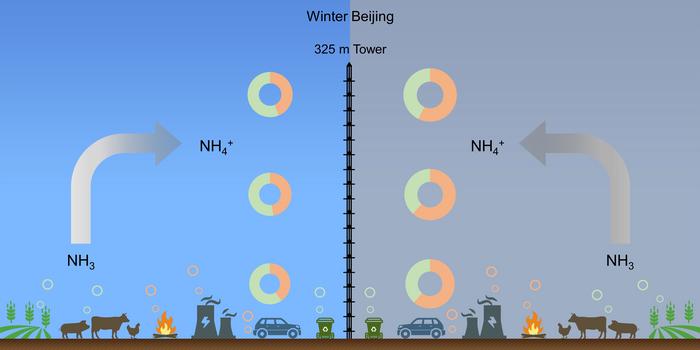Recently, Science Bulletin published a research conducted by Prof. Pingqing Fu and Dr. Libin Wu from Tianjin University, Peng Wang from Fudan University, and their Chinese and foreign collaborators. They explored the source of ammonium in PM2.5 at different heights of the atmospheric boundary layer in Beijing, and found that combustion-related ammonia is very important to ammonium in PM2.5 during haze pollution in winter.

Credit: ©Science China Press
Recently, Science Bulletin published a research conducted by Prof. Pingqing Fu and Dr. Libin Wu from Tianjin University, Peng Wang from Fudan University, and their Chinese and foreign collaborators. They explored the source of ammonium in PM2.5 at different heights of the atmospheric boundary layer in Beijing, and found that combustion-related ammonia is very important to ammonium in PM2.5 during haze pollution in winter.
Air pollution and treatment in Beijing have been widely concerned by both the scientific community and the public. Although its PM2.5 has decreased significantly in the past few years, there is still haze pollution in Beijing, especially in winter. The chemical compositions of PM2.5 are complex, of which ammonium is one of the most important ones. Atmospheric ammonium mainly comes from the secondary reaction of ammonia, which has a significant impact on air pollution, radiation forcing, and human health. In recent years, atmospheric ammonia and ammonium have attracted widespread attention from researchers in the field of atmospheric chemistry. They believe understanding the source of ammonium in PM2.5 can help further improve air quality. However, the source of ammonia in urban areas is still unclear and controversial, and very few studies have paid attention to ammonia or ammonium at different heights in the atmospheric boundary layer, which is not conducive to the development of atmospheric chemistry models and the formulation of emission reduction policies.
Based on the 325-m meteorological tower of the Institute of Atmospheric Physics of the Chinese Academy of Sciences (IAP, CAS), the researchers comprehensively used field observation and atmospheric chemistry models to explore the ammonia emission source and transport mechanism of ammonium in PM2.5 at different heights in the atmospheric boundary layer of Beijing in winter, after improving the nitrogen isotope data of ammonia emission sources. Results from both stable nitrogen isotope analyses and atmospheric chemical model simulation show that combustion-related ammonia, including fossil fuel sources, ammonia slip, and biomass burning, contribute 60% to ammonium during severe haze pollution in winter, exceeding the volatilization-related ammonia including agricultural sources. Most of the combustion-related ammonia emissions come from local Beijing. In contrast, the contribution of volatilization-related ammonia emissions (livestock breading, N-fertilization application, and human waste) dominates on clean days. Biomass burning, especially the indoor combustion of straw and firewood, may be an important ammonia source that has been neglected.
The researchers also used the atmospheric chemistry model to compare the impact of different emission reduction strategies on air pollution, and found that, compared with the reduction of a single pollutant, the simultaneous emission reduction of multiple pollutants has a more obvious effect on reducing PM2.5. To further improve air quality, policies can be considered to simultaneously reduce the emission of multiple pollutants.
Journal
Science Bulletin



